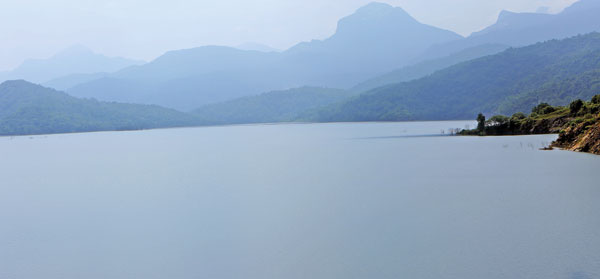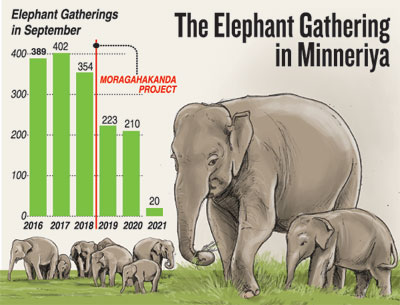News
Moragahakanda dams trigger avalanche of ecological harms
- Environmentalist says Moragahakanda is the most destructive project of all Mahaweli Development initiatives
- Bad planning causes ecological disruption; elephant corridors destroyed aggravating human-elephant conflict; river fish face extinction
The waters of the Amban Ganga on either side, we crossed the towering Moragahakanda dam, the latest addition to the Accelerated Mahaweli Scheme.
And on the eastern side of the threatened Knuckles forest range is the Kalu Ganga dam. Internationally-funded multimillion-dollar infrastructure projects are development keystones in countries like Sri Lanka. But rapid decline of environments, bad planning, absence of data, and resources mismanagement have made them the enemy of sustainable development and conservation.
The Moragahakanda-Kalu Ganga Project is one of three ongoing development projects to improve dry zone irrigation. Completed in 2018, it’s widely alleged that the environmental hurt it causes far outweighs its economic benefits. The reason: bad planning.
The Morgahakanda Reservoir was funded by the China Development Bank, the Kalu Ganga dam by the Saudi Fund for development, the Kuwait Fund for Arab Economic Development, and the OPEC Fund for International Development.
It was considered a “pioneer” project in conservation compared with similar initiatives. But glaring negative impacts have surfaced and are not being resolved owing to official neglect. The structures have destroyed elephant corridors, exacerbating the human-elephant conflict in agricultural areas, especially Matale. Agitated elephants were ruining crops and property built across inter-generational migration routes.
“We have identified about 20 elephants that are causing the damage,” noted a wildlife officer of the Laggala area. The Wildlife Conservation Department (WCD) plans to chase these beasts into the nearby Wasgamuwa National Park. The plan to round them up and corral them into this ‘protected space’ was due to begin in early March but the fuel shortage had scuttled it.
The elephant habitat was substantially destroyed, says Manjula Amararathne, the WCD’s Director of Protected Area Management. But it was difficult to quantify the damage as the project covers other protected areas like the Elahera Sanctuary and Wasgamuwa National Park (part of which was acquired to establish ‘Laggala New Town’ for residents whose homes were submerged when the dam came up).
The outcomes of the Moragahakanda and Kalu Ganga dams on elephants are more far-reaching, even unprecedented, than predicted by the environmental impact assessments (EIAs). The Moragahakanda reservoir’s overflow is decimating the ‘Great Elephant Gathering of Minneriya’. Between 2016 and 2021, there is a 95% drop in elephants assembling there every September, says Sumith Pilapitiya, eminent wildlife researcher and former WCD Director-General.
The irrigation waters of Moragahakanda reservoir were to be channeled through a 28km-long tunnel to Hurulu Wewa, onwards through the existing cascade system for agriculture in the North-Western and North Central Provinces. If there had been proper planning, experts argue, the tunnel should’ve been ready before the reservoir was built.
But the dam was ready in 2018 and the tunnels were still under construction. So the Minneriya reservoir would fill up during the dry season until the last one was completed in 2021. When grasslands on the reservoir bed are submerged, elephants of the ‘Gathering’ no longer have their dry season fodder—something they were accustomed to for generations.
S. Ruwan from the Mahasen Jeep Safari Society works in the Minneriya National Park. The ‘Gathering’, he said, is one the biggest in South-East Asia and attracts hordes of tourists, especially in August-September when around 300 elephants congregate. Since the completion of the Moragahakanda reservoir, this has slumped to around 20, he claimed.
“We’re losing our livelihoods because tourism has taken a hit repeatedly for a few years,” he said. When the park’s main attraction is gone, people stop coming.”
The human-elephant conflict in surrounding areas is also worse now. Mr Ruwan said they want at least a quarter of the Minneriya Reservoir to be left empty so that the ‘Gathering’ could continue in whatever form possible.
Conservation experts assume this off-season water in the Minneriya reservoir is temporary. But Irrigation and Mahaweli Authority officials told the Sunday Times that it had been planned all along to send water from Moragahakanda to Kaudulla and Kantale through the Minneriya reservoir.
When questioned about the repercussions, Irrigation Authority officials said they knew nothing. “There is no elephant problem,” insisted Engineer D. Abeysiriwardene, Director of Water Management. The Minneriya Tank, he also said, was for agriculture, “not for elephants”.
Mr. Abeysiriwardene reiterates that the impact on elephants was a “myth” and that the beasts adjust to new situations. He said the conflict between the Forest Ministry and WCD had given rise to these falsehoods.
EIA team members said, however, that the loss of this critical feeding site had been unpredicted and was now a “huge conservation problem” experts were grappling to solve. It was a matter of “cart before the horse,” said EIA team member Devaka Weerakoon. They had also thought it would be an issue only until the tunnels were done.
The dams should’ve had a fish bypass or a fish ladder, Aquatic Ecologist Ivan Silva also said, because they block the currents that fish rely on to survive. River fish often go extinct in still water. Dams have conditions which, while creating habitats for new species, threaten existing endemic ones.
The EIA hadn’t placed enough importance on at-risk aquatic species. “We will not know exactly how much we’ll lose since a comprehensive study of the fish was also not conducted,” Prof. Silva points out, adding that eels in the Mahaweli are nearly extinct because of the whole Mahaweli Development Project.
“The calculation of fish production is extremely erroneous,” he continued. Deep basins have less fish production because of lower oxygen. But project experts predicted Moragahakanda would have four times the production of Parakrama Samudraya. “I assure you not even half of that will come out of Moragahakanda,” Prof. Silva said.
If there were fish, there’d be fishermen. “How many boats can one see on these reservoirs?” he asked. Faulty predictions such as these throw cost-benefit analyses of the mega projects off balance. A fish ladder recommended by the EIA was shelved due to budget constraints—it was decided the conservation benefits didn’t outweigh the costs.
A fish bypass proved impractical. So the EIA team chose translocation. Three thousand fish were shifted in bags and buckets to the upper regions of the Mahaweli.
The Moragahakanda-Kalu Ganga is the first project of its kind in Sri Lanka with wildlife rescue plans. The inundation of massive areas place animals at risk of dying. The International Union for Conservation of Nature (IUCN) had given local authorities a two-stage programme to secure wildlife in areas that would go under, a spokesman said. But the second stage comprising wildlife evacuation was not completed.
The EIA team, too, collaborated with IUCN in a plan to inundate the area gradually so the animals would travel uphill into islands that would form when the water came in, Prof Weerakoon said. Meticulous calculations were made. This wasn’t followed, however. “Unfortunately, when it comes to money, the environment is at the bottom of the priority list,” he sighed.
The second stage was rushed because of leadership changes at the Mahaweli Authority, an anonymous source told the Sunday Times. Officials sat on blueprints for more than a year due to bureaucratic issues.
While certain that no species were wiped out, Prof Weerakoon warned that some may have been pushed to the brink of extinction. This could be an issue a decade down the line, he said, but cumulative impacts are rarely gauged as most projects are analysed individually. Funding had become a problem, not because there wasn’t enough, but because it was mismanaged.
The EIA team also calculated loss of habitat and forest cover, disturbances to movement patterns, threats to endemic species and the escalation of the human-elephant conflict. Several new protected areas were defined to make up for lost forest cover. Recreation of an ecosystem similar to these forests is not possible but compensatory replanting had been done.
Mahaweli Authority officials insist all plans were followed to completion. A total of 350,000 trees on 9,500 acres were cut down for the two reservoirs, D. B. Wijeratne, Project Director of the Morgahakanda-Kalu Ganga Development Project. Some 575,000 trees were replanted.
The purpose of the initiative was to irrigate the districts of Polonnaruwa, Trincomalee, Anuradhapura, Matale and Kurunegala. To date, he said, all but Kurunegala gets irrigation water from the reservoirs. Cultivators who previously had water only for the Maha season can now also farm during the Yala.
“A total of 100,000 hectares is cultivated annually thanks to the reservoirs and cropping intensity has increased by 1.8%,” Mr. Wijeratne said. These areas were greener, too. Locals in the forest were grateful for the projects as they saw roads being built.
“Back then we couldn’t imagine going to a hospital for an emergency because no vehicle could go on those roads, but now people can travel,” said one villager who sells roti and ‘beli-mal’ near Sera Ella, a tourist attraction.
Buildings had also attracted visitors and this was good for business, another reflected. They could no longer grow certain crops because the climate had shifted significantly but had new revenue streams.
Environmentalists are livid. “Moragahakanda is the most destructive project of all Mahaweli Development initiatives,” maintained Jayantha Wijesinghe, Convener of the Rainforest Protectors. Damage to the pristine forest cover around the Knuckles range was immeasurable. Engineering failures that miscalculated the maximum flood level caused the authorities to cut several roads within ecologically sensitive areas.
To clear villages for catchment, residents were allowed to chop down trees on their properties for commercial use. “What’s the point of allocating a catchment area if all the trees are cut down?” Mr. Wijesinghe asked.
During the days of ancient kings, the central highlands were excluded from their complicated irrigation systems because of their value as a catchment for the whole country. “We’re cutting down the very forests that create rain and hoping more will come,” he warned. “When droughts extend and the reservoir dries up, we will be helpless.”
The Great Elephant Gathering of Minneriya losing its shine The “Great Elephant Gathering” of Minneriya is a world famous tourist attraction named as one of the 10 greatest wildlife wonders of the world by Lonely Planet. “There is no other such sight among the 13 Asian elephant range States and it has been a magnet for tourists, foreign and domestic, in their thousands,” Sumith Pilapitiya, Wildlife Researcher. During the dry season in May-September, elephants gather on the dried out lakebed of the Minneriya reservoir to eat fresh grass. During the peak in September, there are about 400. The numbers go down with the onset of the North-East monsoons in late October. Along with water releases from the cascade reservoir system, the Minneriya reservoir gets filled and the lakebed with its grasses are submerged from December to April. But when water is again released from the reservoir for agriculture in May, the grasslands re-emerge, bring back the elephants. This unique phenomenon has taken place in Minneriya for decades. It is a myth that elephants return to the reservoir during dry season for water. They come for the fresh grass which is higher in protein than mature grass. Water is an added bonus. When food and water are plentiful, elephants, being social animals, congregate in large herds, giving rise to the ‘Great Elephant Gathering’ in August/September. The abundance of resources also triggers their natural biological behaviours. “Having plentiful resources stimulates the sexual hormones of elephants and it is common to observe females in estrus and males in musth,” Dr Pilapitiya said. The unusual sight of mating elephants and its associated male-male competition, musth posturing, and other interesting elephant behavioral characteristics can be observed at this time. Since the construction of the Moragahakanda Reservoir in 2018, however, the Minneriya Reservoir has been full during the dry season due to unseasonal water releases that Irrigation authorities claim are for agricultural reasons. Consequently, there has been a significant reduction in the elephant population. “The project has a virtually irreversible adverse impact on the elephant gathering unless urgent remedial action is taken,” Dr Pilapitiya said. There is about a 95% reduction of elephants of the gathering between 2017 and 2021. Apart from tourism revenue being lost, there appeared to be a greater than six-fold increase in the human-elephant conflict (HEC) in areas around Minneriya National Park. The rise in HEC was confirmed by locals and park safari drivers.
| |
The People of Laggala – resettled or transplanted? Water was once plentiful in Heerati Oya, Nawa Laggala Pallegala. “Now access to good water has become so difficult,” says Ven Kambarawa Samitha Thera, Chief Incumbent of Sri Samakethiyaramaya. He spoke from inside a mud hut erected on land allocated for a new temple. Seven years after resettlement, it is yet to be built. People from the Mahaweli’s right banks were relocated from inundated or catchment areas like Rambukoluwa into newly established towns like Laggala New Town.  Ven Kambarawa Samitha Water comes to town every three days in bowsers. They say it tastes like rust. “More of us have developed pressure, diabetes, and kidney issues,” says Samitha Thera. “Back then we had fresh mountain water.” The government hands out food rations to resettled families–rice, dhal, dry fish and sugar. “These are people that worked hard, earned their own daily needs,” he observed. The compensation lands were painfully disproportionate to the amounts of lands people used to own. “Those who had about 16 acres got only half-an-acre from town,” he said. This was increasingly an issue as families grew. In the past, they had enough property to divide among children. Now, they didn’t. They had to cohabit with their parents or buy land from a more urbanised area. That was too costly for daily-wage earners now also hit by farming difficulties. “There are no factories or big companies around here for people to work in,” Samitha thera said. Elephant attacks had worsened: “Even I sleep in fear.” This is because the town was on the border of Wasgamuwa National Park. Beyond the mountain, in the town of Handunugamuwa, a bear attacked three people, killing one and injuring the others. On a positive note, there was easier access to education and more children attended school for longer. In the old village, the school was 9km away, accessible only on foot and had no electricity. Water was from the nearby river.  Ekanayake Now children were becoming more urbanised than when they lived in the forest. But this had increased alcohol abuse even among those as young as 16. Village kids unaccustomed to town life were giving into unhealthy habits. “Our temple isn’t built yet because we don’t have enough money. As a result, I can’t even ask children to come in the evenings to teach them things,” he sighed. The compensation money wasn’t enough to put up the temple and people didn’t have enough to donate. A majority of the resettled were farmers. The land they received, however, was unfit for paddy cultivation as irrigation channels were far away. “Paddy grows like needles” said C.M. Rathnayake, a father-of-two from Laggala. They have to doser off many layers to reach the water table and this means fertile soil is also lost: “We’re left with gravel to plant in.” Mr. Rathnayake had sowed his land this season. He had low hopes as the agrochemicals ban had hit them in addition to other issues. Water was a challenge. They had thrived on water from the Kalu Ganga. Now, no more. Mainline pipes have been installed but do not function.  Rathnayake “In the village we didn’t pay for electricity. We used the water from the river,” said H M Sudharma, 22. Still, the resettlement gave them better roads and modern opportunities. She completed her A/levels in political science and media two years ago. She is targeting a job in a bag factory the Government said it would set up there. While the resettled struggle to adjust, business owners find their low spending power a challenge. This is worse when cultivation fails. Nobody buys anything but their basic needs nowadays, said M G Ekanayake, an electronic goods seller in town. Resettlement was welcome but “badly planned”—the police station was in the middle of the town while the hospital was further away. And the town doesn’t have sufficient sanitation facilities. The water bowser doesn’t cover the whole town, especially where roads are bad like his lane, he continued: “We’ve been living on water from a well we dug up for the past four months because the bowser hasn’t come.” (Reporting for this story was supported by Internews’ Earth Journalism Network) |
The best way to say that you found the home of your dreams is by finding it on Hitad.lk. We have listings for apartments for sale or rent in Sri Lanka, no matter what locale you're looking for! Whether you live in Colombo, Galle, Kandy, Matara, Jaffna and more - we've got them all!


